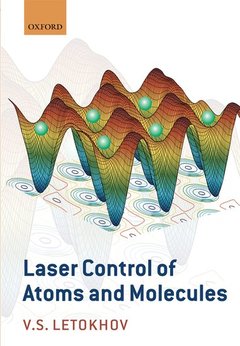Description
Laser Control of Atoms and Molecules
Author: Letokhov Vladilen
Language: English
Subjects for Laser Control of Atoms and Molecules:
Laser control of atoms and molecules (paperback)
Publication date: 10-2011
324 p. · 16.8x24.2 cm · Hardback
Publication date: 10-2011
324 p. · 16.8x24.2 cm · Hardback
Laser control of atoms and molecules
Publication date: 02-2007
324 p. · 17x25 cm · Hardback
Publication date: 02-2007
324 p. · 17x25 cm · Hardback
Description
/li>Contents
/li>Biography
/li>Comment
/li>
Rather different problems can be lumped together under the general term 'laser control of atoms and molecules'. They include the laser selection of atomic and molecular velocities for the purpose of Doppler-free spectroscopy, laser control of the position and velocity of atoms (i.e. laser trapping and cooling of atoms), and laser control of atomic and molecular processes (ionization, dissociation) with a view of detecting single atoms and molecules and particularly separating isotopes and nuclear isomers. Over the last decades the principal problems posed have been successfully solved, and many of them have evolved remarkably in the subsequent investigations of the international research community. For example, the solution of the problem of laser cooling and trapping of atoms has given birth to the new field of the physics of ultracold matter, i.e. quantum atomic and molecular gases. The laser non-coherent control of uni-molecular processes has found an interesting extension in the field of laser coherent control of molecules. The concept of laser control of position has been successfully demonstrated with microparticles (optical tweezers), concurrently with investigations into atomic control. The laser photo-ionization of molecules on surfaces has led to the development of novel techniques of laser-assisted mass spectrometry of macromolecules, and so on. The aim of this book is to review these topics from a unified or 'coherent' point of view. It will be useful for many readers in various fields of laser science and its applications.
1. Introduction. 2. Elementary radiative processes. 3. Laser velocity-selective excitation. 4. Optical orientation of atoms and nuclei. 5. Laser cooling of atoms. 6. Laser trapping of atoms. 7. Atom optics. 8. From laser-cooled and trapped atoms to atomic and molecular quantum gases. 9. Laser photoselective ionization of atoms. 10. Multiphoton ionization of molecules. 11. Photoselective laser control of molecules via molecular vibrations. 12. Coherent laser control of molecules. 13. Related topics: laser control of microparticles and force electrons. Conclusion.
Vladilen Letokhov was born in Irkutsk, Siberia (1939). Educated in the prestigious Moscow Physical-Technical Institute (1957-1963). Graduated in P.N.Lebedev Physical Institute in Moscow with Nobel Prize Winner Professor N.Basov. From 1970 Letokhov was the Head of Laser Spectroscopy Laboratory and associate director for research (1971-1989) of the Institute of Spectroscopy, Russian Academy of Sciences. Was most recently Professor at the Moscow Physical-Technical Institute. Awards: Lenin Prize for science and technology (1978); State Prize for science and technology (2002); European Physical Society Quantum Electronics Prize (1998)
Letokhov has managed the difficult feat of both describing the physics of a wide range of topics while also looking to the future. Anyone with an interest in atomic physics will enjoy this book.
© 2024 LAVOISIER S.A.S.




